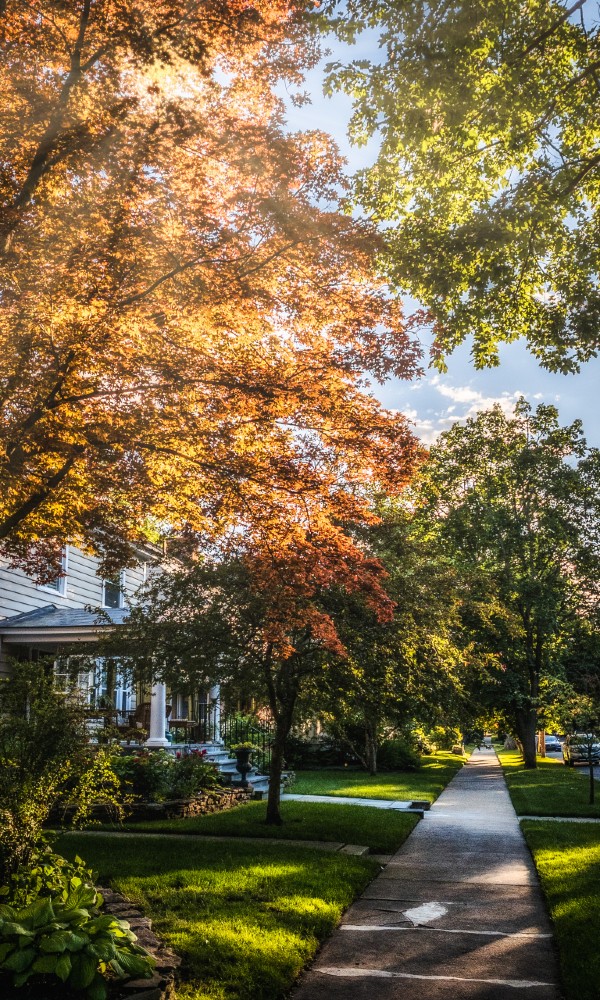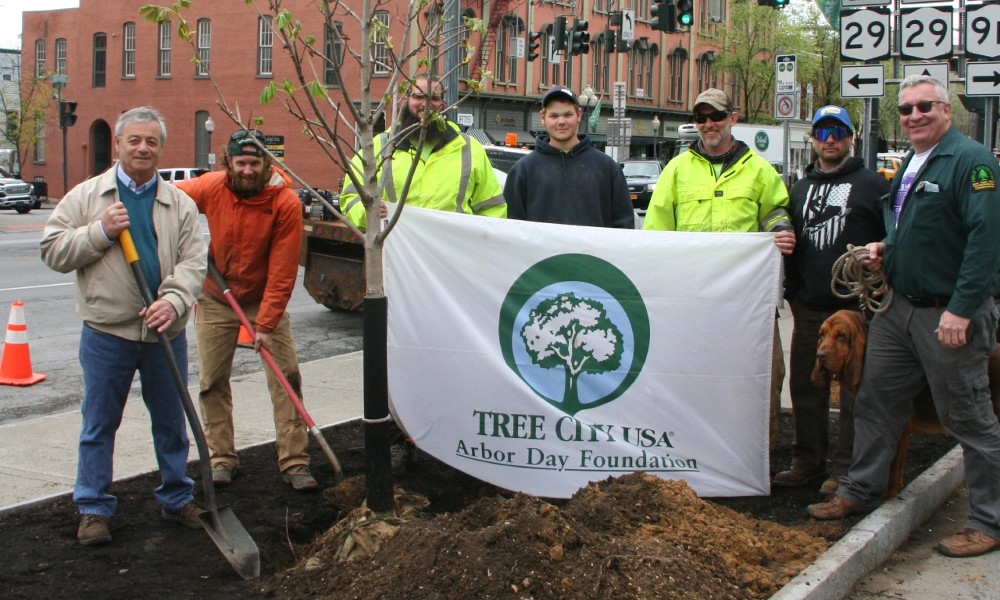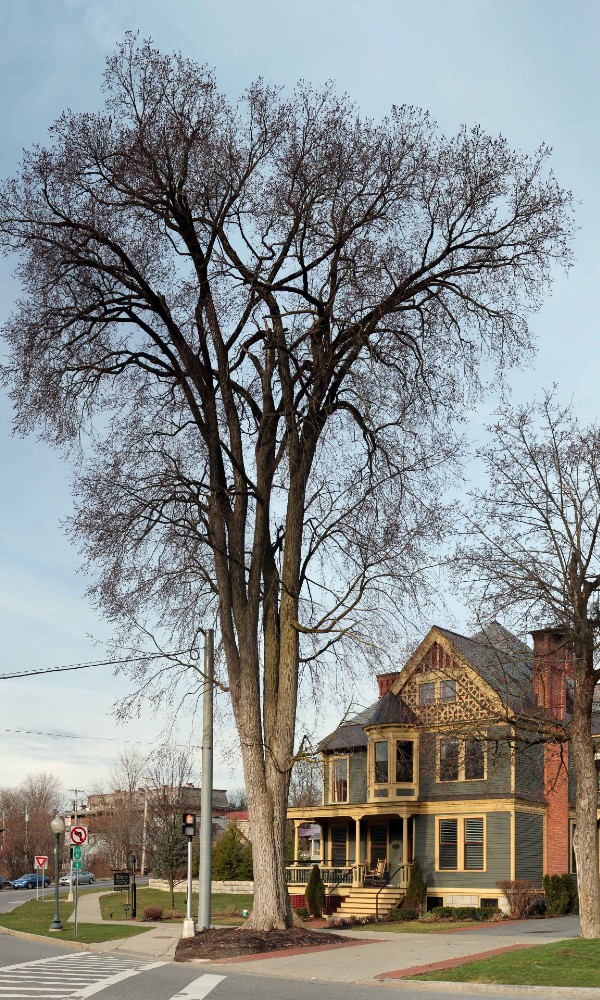Over lunch at the Cantina bar, I offhandedly asked my companion, 35-year Saratoga resident Max Oswald, if he had any tree stories. “Tree stories?” he asked, perplexed, as if that was the first time he’d been lobbed that question. (I’m sure it was.) I nodded, and he took a sip of his Crimson Berry Hard Tea. “Well, there was this spooky old tree…”
It’s not so much a story as a memory—when Max’s son, Jake, was little, the two would walk from their house on East Ave to East Side Rec, usually to play baseball. On the way home, they’d take Lake Ave and have to pass the “spooky old tree,” which they named after a favorite Berenstain Bears book. Whenever they got close to it, they’d sprint past, so as not to be spooked by its knotty trunk and scraggly limbs, slowing to a walk only after they were sure they were safe.
Max and Jake’s Spooky Old Tree is just one of the many trees that has made up Saratoga’s ever-changing urban and community forest—the city’s collection of public- and privately-owned trees and vegetation—since Gideon Putnam first arrived in 1789. “This is a healthy place,” Putnam famously said to his wife upon his arrival, before adding a bit of foreshadowing: “The mineral waters are valuable and the timber is good and in great abundance.” Putnam said “timber” instead of “trees” for a reason—in the years that followed, Saratoga’s founding father operated a highly successful sawmill that shipped wood down the Hudson River to New York City, effectively decimating the local tree population. By 1800, there “was not shade enough to shelter a dog,” per one traveler to Congress Spring. The area that’s now Downtown Saratoga remained largely treeless until 1828, when hope for tree lovers was planted via passed legislation that reduced the highway tax by 62.5 cents for any “person planting the trees.” As a result, Saratoga became famous for the trees that lined its main street. “So perfect is the shade of Saratoga’s tree-lined avenues,” a visitor to Saratoga poetically noted in the New York Times in 1890, “that midsummer weather is robbed of its terrors when it crosses her threshold.”

Throughout the early 20th century, many of Saratoga’s trees succumbed to infestations, blights and diseases (the most famous being the mid–20th century Dutch elm disease epidemic), and by the 1970s the city was almost as barren as it had been in 1800. But yet again, the urban forest bounced back, as a group of concerned citizens teamed up with the Department of Public Works (DPW) to plant 250 trees in 4-foot by 4-foot holes in the central business district as part of Saratoga’s Plan of Action. By 2013, many of the city’s older, mature trees continued to succumb to disease and the stresses of an urban environment, while the tree pits built in the ’70s proved to not offer adequate soil, moisture or oxygen for the growing younger trees. That’s when Saratoga adopted its Urban and Community Forest Master Plan (UCFMP), a 115-page document with the goal to preserve and expand the urban forest. “‘Preserve’ means that you try to keep as many trees as possible, even in development projects, and try to nurture trees so that they have as long a life as possible,” says Tom Denny, chair of Sustainable Saratoga’s Urban Forestry Project. “And then ‘expand’ requires planting, obviously.”
Since its founding in 2011, the Urban Forestry Project has been working in tandem with the DPW on these two goals. While the City is obligated to care only for those trees on City property and in the right-of-way (the area between the road and private property), Sustainable Saratoga plants trees on private land as well. To date, the environmental nonprofit has planted 270 trees through its annual Tree Toga plantings, as well as advocated for existing trees in the city, such as the 37-inch DBH (diameter at breast height) oak on Cherry Street, which was at risk of being taken down during the development of the City Square townhomes. “That tree would’ve been gone without our effort,” Denny says. “That’s probably the most important save that we’ve accomplished.”
But there are some trees that neither Sustainable Saratoga nor the City of Saratoga have been able to save, including a 200-plus-year-old, 57-inch DBH oak that was removed by a homeowner in 2014. There’s currently no ordinance in place that regulates the removal of trees on private or institutional land, and often, private property owners choose convenience (i.e. not having to rake leaves or clear fallen limbs) over preservation, while developers choose to clear a property and plant from scratch rather than build around existing, established trees. Other trees, such as the Norway maple, are invasive and negatively impact the environment and city, so are taken down even if they’re healthy.
With trees coming down across the city for all different reasons, the main methods of preservation Sustainable Saratoga has been using is planting more (noninvasive) trees and educating Saratogians about the importance of trees in an urban environment and the stresses urban trees face. Obviously, urban trees offer the same benefits as all trees—they provide a home for hundreds of species of insects, fungi, moss, mammals and plants; help cool the planet by storing carbon dioxide; and literally give us the air we need to breathe. But urban trees also reduce air conditioning costs by shading homes, improve stormwater management by retaining rainwater, improve public health by filtering pollutants out of the air, and even boost the economy by raising property values and beautifying downtowns. As for the stresses they face, urban trees are at much greater risk than their rural counterparts. Urban trees have to withstand restricted root-growth areas, road-salt exposure, compaction of the soil around roots by foot and vehicle traffic, pollution, and detrimental “mulch volcanoes,” the piles of bark chips homeowners often place around the base of trees. “People like to bury trees in mulch,” says Steven Lashomb, Saratoga’s City arborist. “Keep it three inches away from the trunk. Roots need air.”

Lashomb leads a tree crew of five people (including himself) whose job it is to maintain City trees—prune them when they interfere with utility wires or pose a threat to public safety, and remove them when they’re dead or diseased, such as the towering American elm that stood outside Witt Construction’s office until earlier this year. The City invests more than $360,000 into trees each year, a seemingly large sum that is, in reality, all too necessary. In a July New York Times article, Dr. Brian Stone Jr., a professor of environmental planning at the Georgia Institute of Technology, put it this way: “It’s hard for us to think of trees as actual infrastructure rather than an amenity, and because of that, we don’t allocate sufficient funds. If we think about trees as actual infrastructure on par with investing in roads and sewers and everything else, those costs will become more acceptable to us.”
Saratogians do get this, says Commissioner of Public Works Anthony “Skip” Scirocco. “I’ve got to give a lot of credit to the residents of the city,” he says. “They realize the benefits of the trees and what they actually do for the environment and the climate. We get calls all the time from residents that want trees planted.”
So if Saratogians realize the importance of the urban forest, and the City itself has been following this Bible-thick master plan of how best to preserve it, how does that compare to the urban forest health of other cities? “I would say we’re definitely not in the worst shape, and we’re definitely not in the vanguard of protecting our trees, compared to some cities,” Denny says. “There’s a group down in Schenectady called ReTree Schenectady. They’ve been active for about 25 years and have planted 3,000 trees. We’ve planted 270.” But the 270 planted by Sustainable Saratoga is in addition to the more than 100 planted by the City annually, a figure that’s only increasing year after year. Furthermore, in 2016 Saratoga achieved Tree City USA status, a designation awarded by the Arbor Day Foundation that requires a community to maintain a tree board or department, have a community tree ordinance, spend at least $2 per capita on urban forestry, and celebrate Arbor Day. Up until last year, Saratoga was the only Tree City USA in the New York Department of Environmental Conservation’s (DEC’s) Region 5, an area that stretches from Saratoga up to the Canadian border, per Lashomb, who serves as the cochair of the Region 5 Relief Committee. “I don’t think any other municipality has a master plan in Region 5,” Lashomb adds. “I think that says a lot.”

But just because Saratoga is ahead of the rest of the region doesn’t mean its tree crew can sit back and relax. “We’ve got a lot of work to do,” Lashomb says. “The biggest issue is past practices, where people didn’t consider the size that trees were going to grow to and what kind of conflicts were going to happen surrounding infrastructure.” To move the management of Saratoga’s urban forest forward, Lashomb helped the City win a $50,000 grant from the DEC for an inventory and management plan for all the trees in the right-of-way. Over the next year and a half, a team of certified arborists will collect information on the City’s trees, which will then be input into asset management software that can be continuously updated as the urban forest changes. “It’s going to be a big game-changer once it’s completed,” Lashomb says. “Once we know what we need to do, we can start revising the UCFMP and achieving a lot of the things that we want to achieve that are in there.” One of those stated goals in the UCFMP, for example, is the establishment of a “heritage tree” program to recognize Saratoga’s greatest trees—ones that would be candidates for some form of preservation, protection or special care—such as the American elm that stands outside the Roohan Realty building on Broadway.
Sometime between the late ’90s and today, the Spooky Old Tree I learned about at Cantina was removed, though Max doesn’t know why and can’t remember exactly when. If Saratoga had a heritage tree program, would it still be standing today? Maybe. “Heritage Trees are part of the historical fabric of a great city,” the UCFMP notes. “They are treasured for their beauty and for the way in which they evoke the past. They are a great educational resource, a tangible legacy that inspires the imagination.”
Given that definition, the Spooky Old Tree most certainly would have qualified for heritage tree status and been saved. But even though the tree’s long gone, its legacy hasn’t been forgotten.
